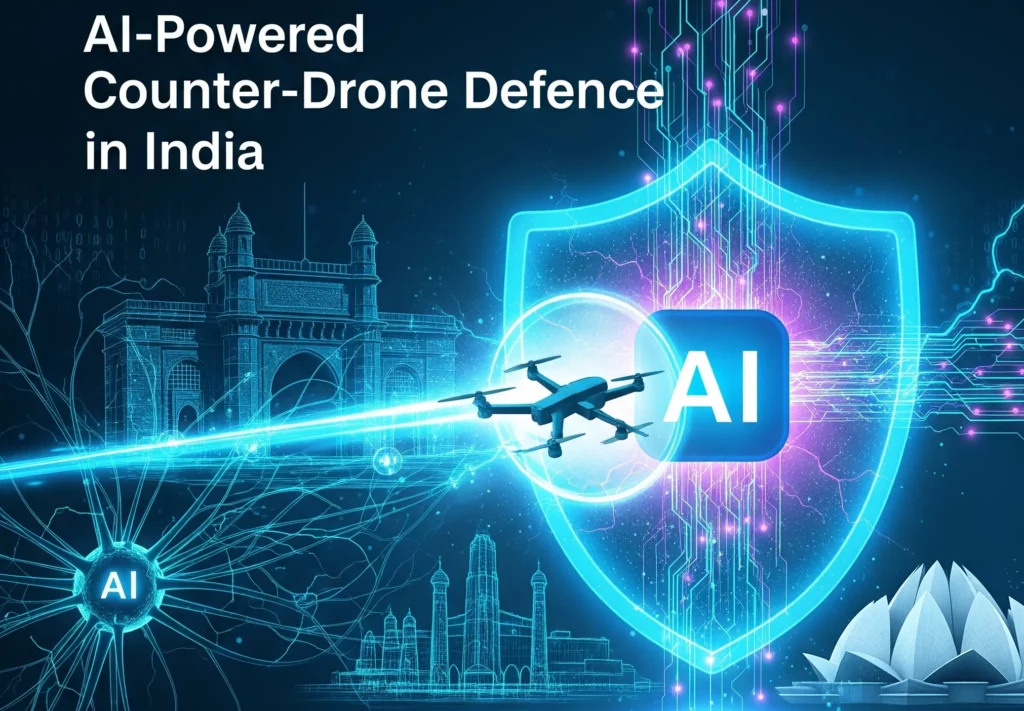Introduction
The growing use of drones—ranging from hobby quadcopters to advanced unmanned aerial systems—has reshaped the security landscape worldwide. In conflict zones, drones have proven their ability to carry out surveillance, deliver payloads, and even execute swarm attacks. For a country like India, which faces both conventional and asymmetric threats, counter-drone defence is no longer optional. Artificial Intelligence (AI) has emerged as the critical enabler that allows detection, tracking, classification, and neutralisation of these fast, low-flying, and often autonomous aerial threats.
The Nature of the Drone Threat
Modern drones are inexpensive, highly manoeuvrable, and increasingly autonomous. They can:
- Fly at low altitudes, escaping conventional radar coverage.
- Operate at night or under conditions that reduce visibility.
- Communicate silently, using pre-programmed routes that bypass radio-frequency (RF) detection.
- Attack in swarms, overwhelming human operators with numbers.
Traditional defences—such as static radars, manual monitoring, or simple RF jammers—are inadequate against such evolving challenges. AI-driven systems provide the necessary edge by automating detection, prioritisation, and response.
India’s Counter-Drone Developments
1. DRDO–BEL Integrated Drone Detection and Interdiction System (IDDIS)
India’s Defence Research and Development Organisation (DRDO), in collaboration with Bharat Electronics Limited (BEL), has developed the IDDIS. This system integrates radars, electro-optical sensors, RF detectors, and jammers to provide real-time search, detection, and neutralisation. It offers both soft-kill options (jamming, spoofing) and hard-kill measures. In May 2025, contracts were signed with the Indian Army, signalling operational maturity and confidence in the system’s effectiveness.

2. Indrajaal: Autonomous Drone Defence Dome
Developed by Grene Robotics, Indrajaal is an AI-powered, wide-area defence system capable of protecting up to 4,000 km² of airspace. It uses sensor fusion—combining radar, electro-optical, RF, and thermal feeds—to detect and classify threats. Its AI-driven decision engine can autonomously trigger responses according to pre-set rules of engagement, ensuring rapid action against swarms or coordinated drone intrusions. Indrajaal represents a shift from reactive defence to autonomous, predictive airspace management.

3. Bhargavastra: Hard-Kill Countermeasure
In May 2025, Solar Defence & Aerospace tested Bhargavastra, a micro-missile system designed to intercept drones and swarms within seconds. Unlike jammers, which are ineffective against pre-programmed drones, Bhargavastra offers a hard-kill solution—physically destroying targets. The system demonstrated interception under 16 seconds during trials at the Seaward Firing Range, Gopalpur, in the presence of Army officials. Its development signals India’s readiness to adopt layered counter-drone strategies that combine electronic and kinetic defence.

How AI Transforms Counter-Drone Systems
AI technologies underpin the effectiveness of these systems in several ways:
- Sensor Fusion: AI combines radar signals, electro-optical imagery, acoustic patterns, and RF telemetry to create a unified track of each target, even in cluttered environments.
- Real-Time Classification: Computer vision and machine learning models identify the type of drone, payload, and intent, helping operators prioritise responses.
- Autonomous Response Policies: AI-driven engines match threats with suitable countermeasures—jamming, spoofing, or kinetic action—within milliseconds.
- Resilience at the Edge: AI algorithms embedded in local devices ensure operations continue even when network connectivity is contested or jammed.
Towards Layered Defence Architectures
Experts increasingly recommend a layered approach to counter-drone defence:
- Detection Layer: Always-on sensors (radar, EO/IR, RF) that feed into AI models for constant monitoring.
- Soft-Kill Layer: Jammers and spoofers to deny control and force drones to land or return to their base.
- Hard-Kill Layer: Systems like Bhargavastra that physically intercept drones when electronic measures fail.
- Command Layer: AI-enabled control platforms that integrate all inputs and outputs, reducing decision latency.
Such architectures ensure redundancy and resilience, making it harder for adversaries to penetrate defended airspace.
Governance and Safety
While AI offers speed and precision, the deployment of counter-drone systems raises important questions of governance:
- Human Oversight: Autonomous engagement must retain a human “in the loop” for lethal responses.
- Fail-Safes: Systems must avoid misclassification of civilian drones, aircraft, or birds.
- Auditability: Transparent logs and performance metrics—such as detection time, classification accuracy, and false alarm rates—are essential for accountability.
These safeguards ensure that the adoption of AI-powered defence does not compromise ethical and safety standards.
Conclusion
India’s counter-drone ecosystem has entered a decisive phase. With DRDO–BEL systems now in service, private innovations like Indrajaal demonstrating autonomous wide-area protection, and Bhargavastra introducing hard-kill capability, the nation is building a comprehensive, AI-powered air defence framework.
The future of counter-drone warfare will not be defined by any single technology but by the integration of multiple layers—sensors, AI analytics, and effectors—working together. As drone threats grow more complex, AI will remain the critical force multiplier that enables rapid, precise, and reliable defence of India’s skies.

